warning DODGE GRAND CARAVAN 2004 User Guide
[x] Cancel search | Manufacturer: DODGE, Model Year: 2004, Model line: GRAND CARAVAN, Model: DODGE GRAND CARAVAN 2004Pages: 397, PDF Size: 7.59 MB
Page 39 of 397
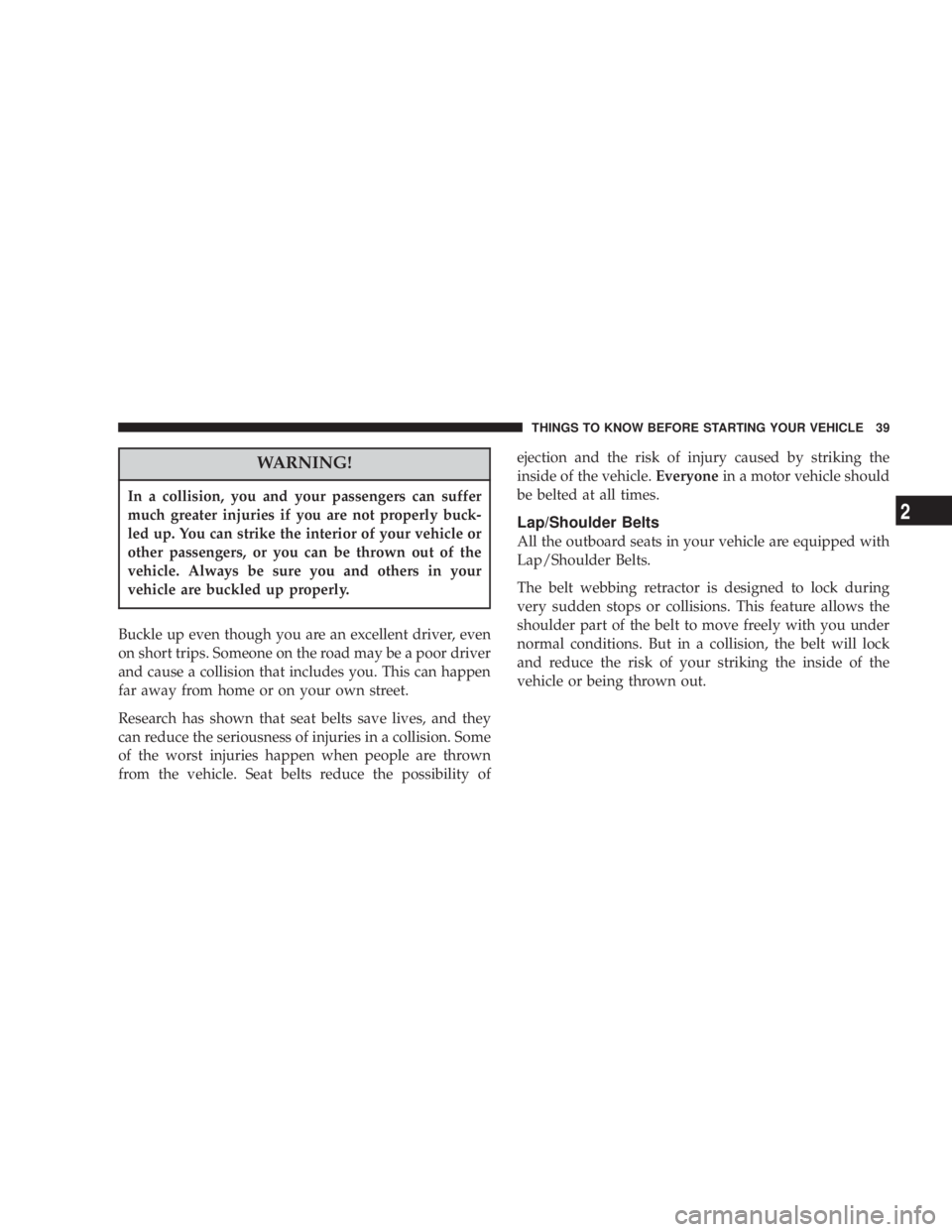
WARNING!In a collision, you and your passengers can suffer
much greater injuries if you are not properly buck-
led up. You can strike the interior of your vehicle or
other passengers, or you can be thrown out of the
vehicle. Always be sure you and others in your
vehicle are buckled up properly.
Buckle up even though you are an excellent driver, even
on short trips. Someone on the road may be a poor driver
and cause a collision that includes you. This can happen
far away from home or on your own street.
Research has shown that seat belts save lives, and they
can reduce the seriousness of injuries in a collision. Some
of the worst injuries happen when people are thrown
from the vehicle. Seat belts reduce the possibility of ejection and the risk of injury caused by striking the
inside of the vehicle. Everyone in a motor vehicle should
be belted at all times.
Lap/Shoulder Belts
All the outboard seats in your vehicle are equipped with
Lap/Shoulder Belts.
The belt webbing retractor is designed to lock during
very sudden stops or collisions. This feature allows the
shoulder part of the belt to move freely with you under
normal conditions. But in a collision, the belt will lock
and reduce the risk of your striking the inside of the
vehicle or being thrown out. THINGS TO KNOW BEFORE STARTING YOUR VEHICLE 39
2
Page 40 of 397
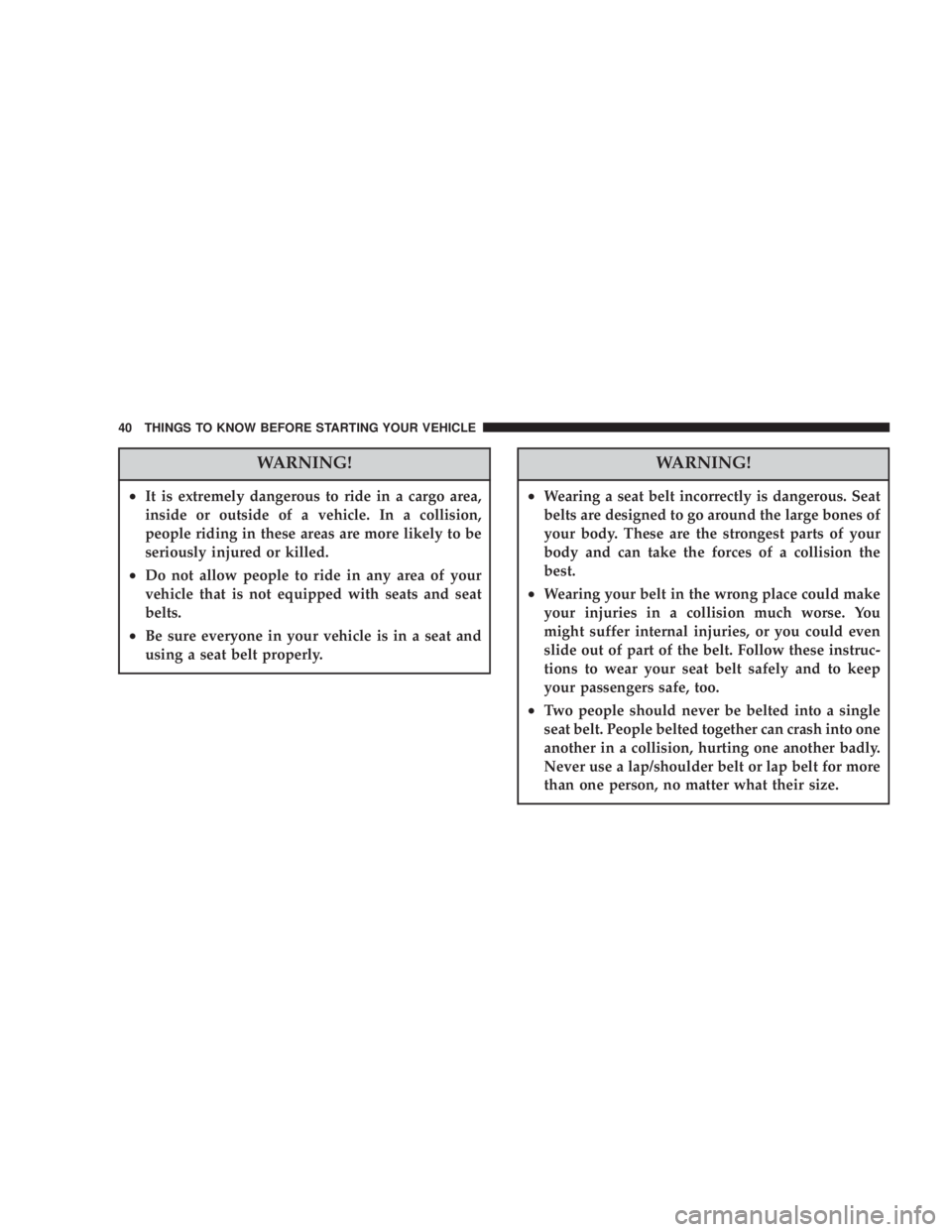
WARNING!² It is extremely dangerous to ride in a cargo area,
inside or outside of a vehicle. In a collision,
people riding in these areas are more likely to be
seriously injured or killed.
² Do not allow people to ride in any area of your
vehicle that is not equipped with seats and seat
belts.
² Be sure everyone in your vehicle is in a seat and
using a seat belt properly. WARNING!² Wearing a seat belt incorrectly is dangerous. Seat
belts are designed to go around the large bones of
your body. These are the strongest parts of your
body and can take the forces of a collision the
best.
² Wearing your belt in the wrong place could make
your injuries in a collision much worse. You
might suffer internal injuries, or you could even
slide out of part of the belt. Follow these instruc-
tions to wear your seat belt safely and to keep
your passengers safe, too.
² Two people should never be belted into a single
seat belt. People belted together can crash into one
another in a collision, hurting one another badly.
Never use a lap/shoulder belt or lap belt for more
than one person, no matter what their size.40 THINGS TO KNOW BEFORE STARTING YOUR VEHICLE
Page 42 of 397
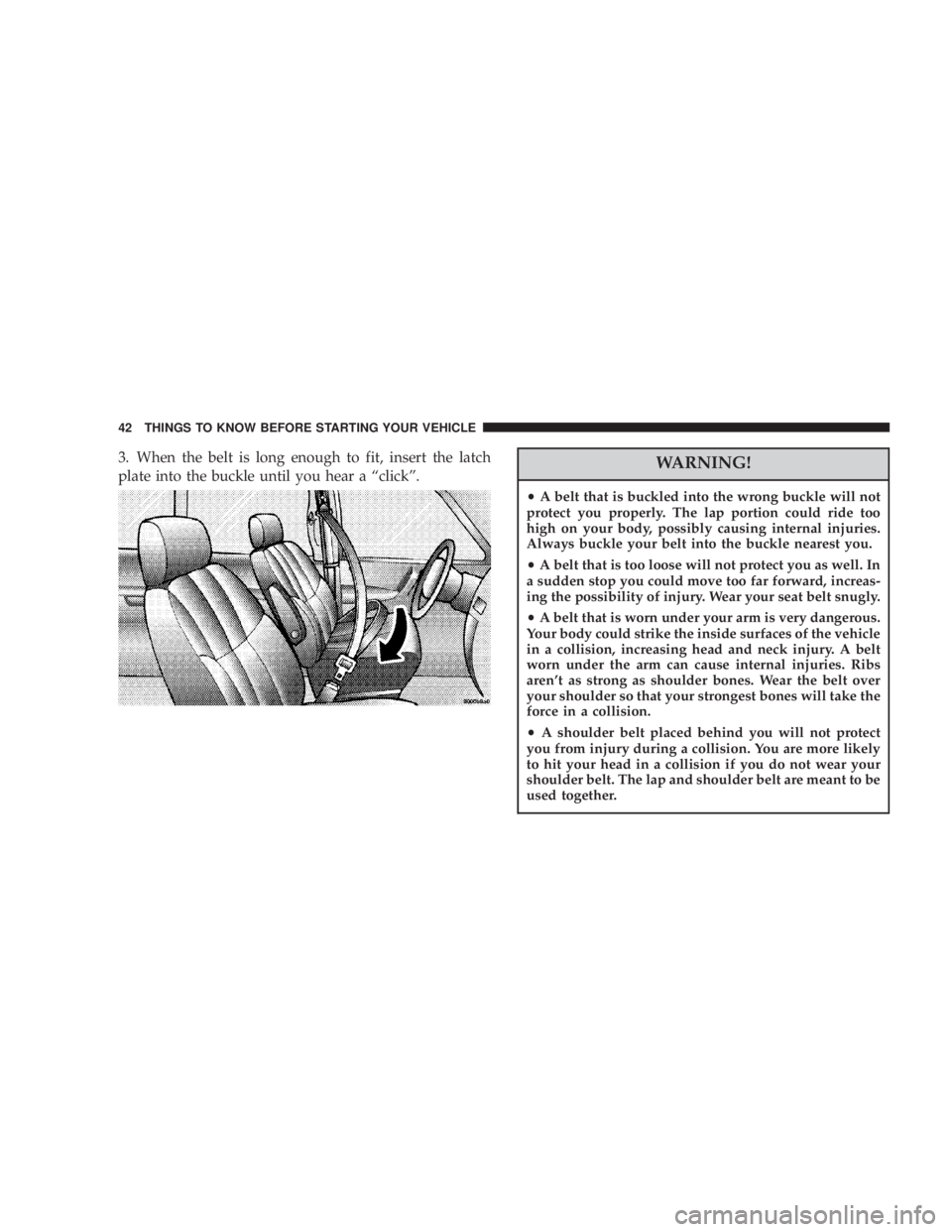
3. When the belt is long enough to fit, insert the latch
plate into the buckle until you hear a ªclickº.
WARNING!² A belt that is buckled into the wrong buckle will not
protect you properly. The lap portion could ride too
high on your body, possibly causing internal injuries.
Always buckle your belt into the buckle nearest you.
² A belt that is too loose will not protect you as well. In
a sudden stop you could move too far forward, increas-
ing the possibility of injury. Wear your seat belt snugly.
² A belt that is worn under your arm is very dangerous.
Your body could strike the inside surfaces of the vehicle
in a collision, increasing head and neck injury. A belt
worn under the arm can cause internal injuries. Ribs
aren't as strong as shoulder bones. Wear the belt over
your shoulder so that your strongest bones will take the
force in a collision.
² A shoulder belt placed behind you will not protect
you from injury during a collision. You are more likely
to hit your head in a collision if you do not wear your
shoulder belt. The lap and shoulder belt are meant to be
used together.42 THINGS TO KNOW BEFORE STARTING YOUR VEHICLE
Page 43 of 397
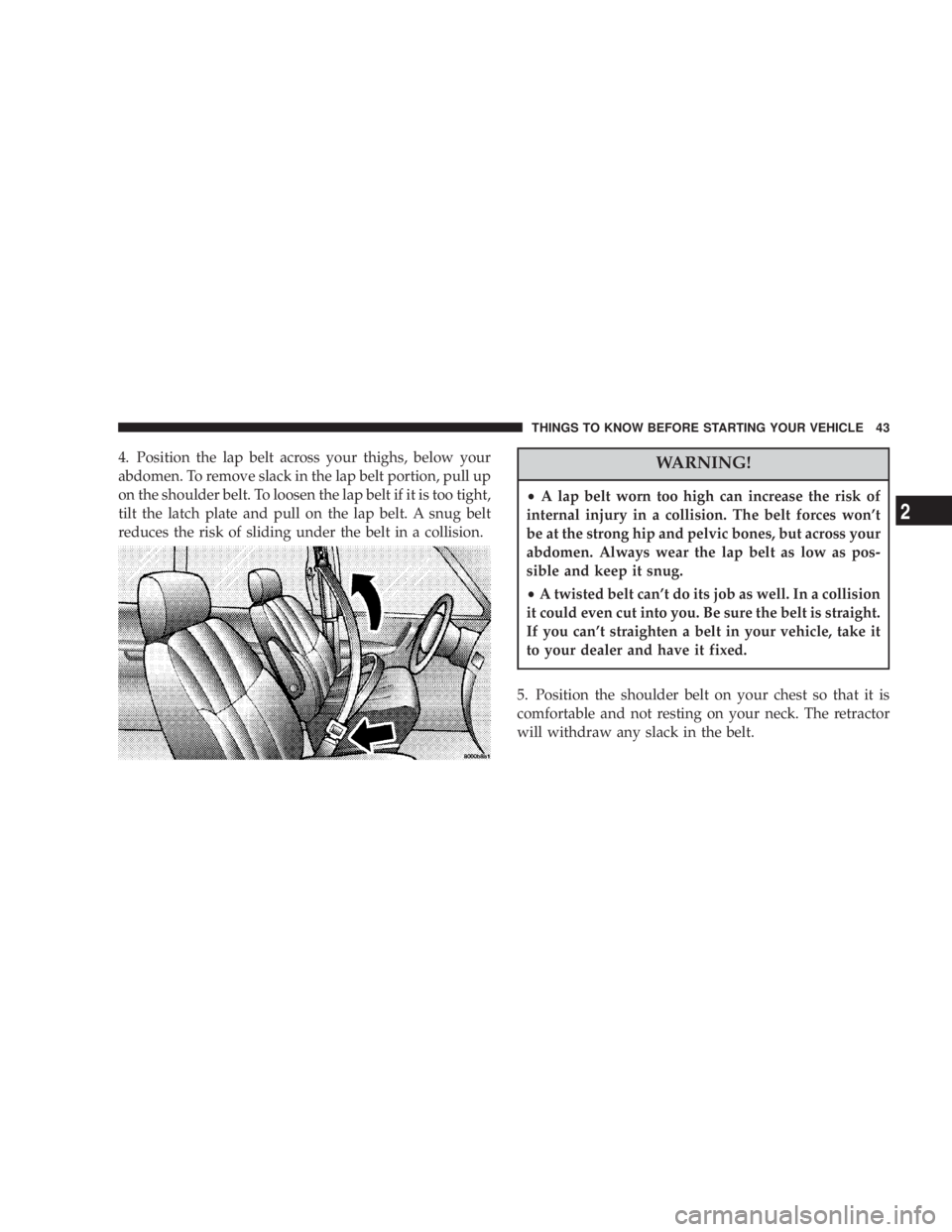
4. Position the lap belt across your thighs, below your
abdomen. To remove slack in the lap belt portion, pull up
on the shoulder belt. To loosen the lap belt if it is too tight,
tilt the latch plate and pull on the lap belt. A snug belt
reduces the risk of sliding under the belt in a collision.
WARNING!² A lap belt worn too high can increase the risk of
internal injury in a collision. The belt forces won't
be at the strong hip and pelvic bones, but across your
abdomen. Always wear the lap belt as low as pos-
sible and keep it snug.
² A twisted belt can't do its job as well. In a collision
it could even cut into you. Be sure the belt is straight.
If you can't straighten a belt in your vehicle, take it
to your dealer and have it fixed.
5. Position the shoulder belt on your chest so that it is
comfortable and not resting on your neck. The retractor
will withdraw any slack in the belt. THINGS TO KNOW BEFORE STARTING YOUR VEHICLE 43
2
Page 44 of 397

6. To release the belt, push the red button on the buckle.
The belt will automatically retract to its stowed position.
If necessary, slide the latch plate down the webbing to
allow the belt to retract fully.
WARNING!A frayed or torn belt could rip apart in a collision
and leave you with no protection. Inspect the belt
system periodically, checking for cuts, frays, or loose
parts. Damaged parts must be replaced immediately.
Do not disassemble or modify the system. Seat belt
assemblies must be replaced after a collision if they
have been damaged (bent retractor, torn webbing,
etc.).
Adjustable Upper Shoulder Belt Anchorage
In the front seats and the second row outboard seats, the
shoulder belt anchorage can be adjusted upward or downward to help position the belt away from your
neck. The upper anchorage can be adjusted upward by
pushing anywhere on the anchorage. To move the an-
chorage downward, press the actuation button while
simultaneously pushing down on the anchorage assem-
bly.44 THINGS TO KNOW BEFORE STARTING YOUR VEHICLE
Page 47 of 397

Center Lap Belts
The center seating positions have a lap belt only. To fasten
the lap belt, slide the latch plate into the buckle until you
hear a ªclickº. To lengthen the lap belt, tilt the latch plate
and pull. To remove slack, pull the loose end of the
webbing.
Wear the lap belt snug against the hips. Sit back and erect
in the seat, then adjust the belt as tightly as is comfortable.
WARNING!² A lap belt worn too loose or too high is dangerous.
² A belt worn too loose can allow you to slip down
and under the belt in a collision.
² A belt that is too high will apply crash forces to
the abdomen, not to the stronger hip bones. In
either case, the risk of internal injuries is greater.
Wear a lap belt low and snug. Seat Belt Pretensioners
The seat belts for both front seating positions are
equipped with pretensioning devices that are designed to
remove slack from the seat belt in the event of a collision.
These devices improve the performance of the seat belt
by assuring that the belt is tight about the occupant early
in a collision. Pretensioners are designed to work for all
size occupants.
NOTE: These devices are not a substitute for proper seat
belt placement by the occupant. The seat belt still must be
worn snugly and positioned properly.
The pretensioners are triggered by the front airbag con-
trol module (see Front Airbag Section). Like the front
airbags, the pretensioners are single use items. After a
collision that is severe enough to deploy the front airbags
and pretensioners, both must be replaced. THINGS TO KNOW BEFORE STARTING YOUR VEHICLE 47
2
Page 48 of 397
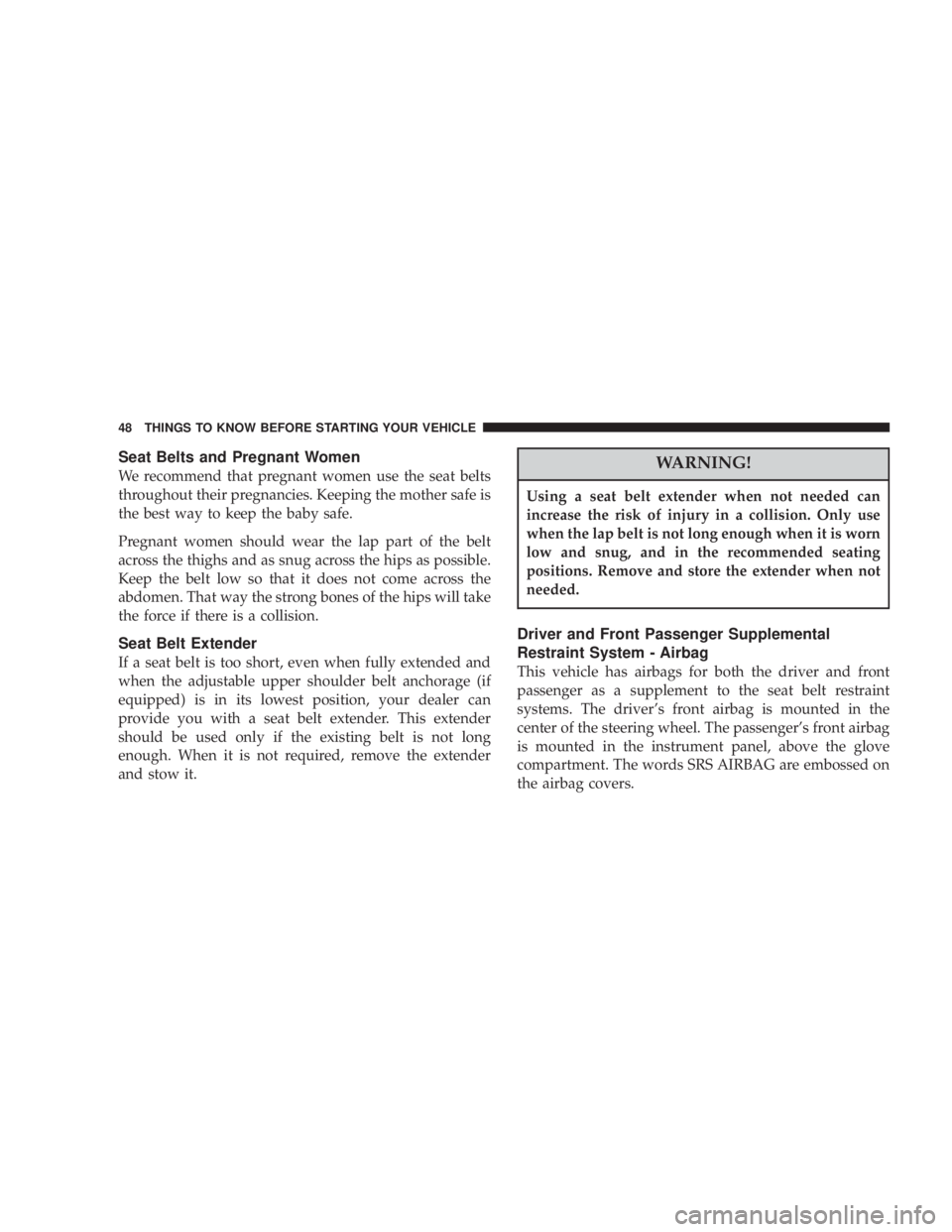
Seat Belts and Pregnant Women
We recommend that pregnant women use the seat belts
throughout their pregnancies. Keeping the mother safe is
the best way to keep the baby safe.
Pregnant women should wear the lap part of the belt
across the thighs and as snug across the hips as possible.
Keep the belt low so that it does not come across the
abdomen. That way the strong bones of the hips will take
the force if there is a collision.
Seat Belt Extender
If a seat belt is too short, even when fully extended and
when the adjustable upper shoulder belt anchorage (if
equipped) is in its lowest position, your dealer can
provide you with a seat belt extender. This extender
should be used only if the existing belt is not long
enough. When it is not required, remove the extender
and stow it. WARNING!Using a seat belt extender when not needed can
increase the risk of injury in a collision. Only use
when the lap belt is not long enough when it is worn
low and snug, and in the recommended seating
positions. Remove and store the extender when not
needed.
Driver and Front Passenger Supplemental
Restraint System - Airbag
This vehicle has airbags for both the driver and front
passenger as a supplement to the seat belt restraint
systems. The driver's front airbag is mounted in the
center of the steering wheel. The passenger's front airbag
is mounted in the instrument panel, above the glove
compartment. The words SRS AIRBAG are embossed on
the airbag covers.48 THINGS TO KNOW BEFORE STARTING YOUR VEHICLE
Page 50 of 397
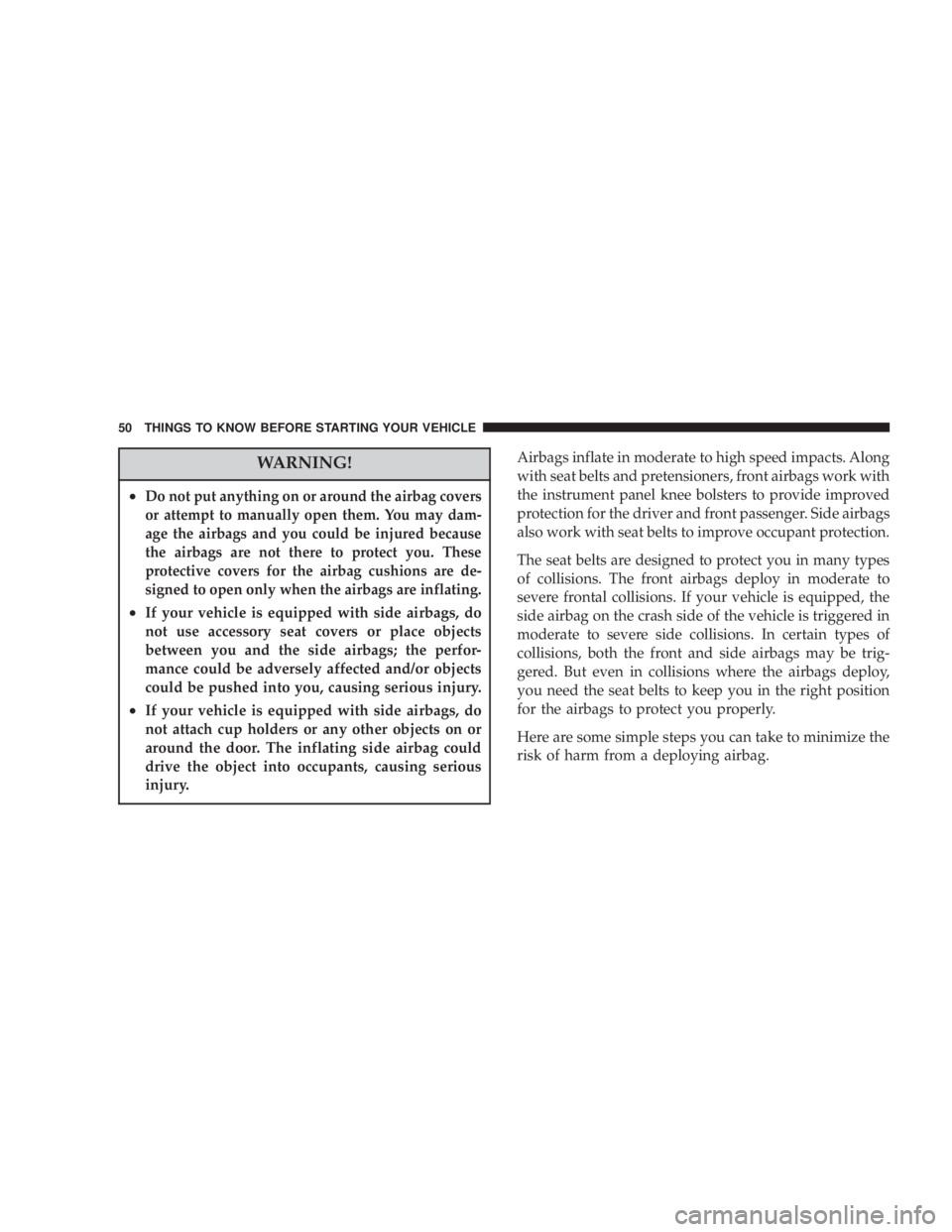
WARNING!² Do not put anything on or around the airbag covers
or attempt to manually open them. You may dam-
age the airbags and you could be injured because
the airbags are not there to protect you. These
protective covers for the airbag cushions are de-
signed to open only when the airbags are inflating.
² If your vehicle is equipped with side airbags, do
not use accessory seat covers or place objects
between you and the side airbags; the perfor-
mance could be adversely affected and/or objects
could be pushed into you, causing serious injury.
² If your vehicle is equipped with side airbags, do
not attach cup holders or any other objects on or
around the door. The inflating side airbag could
drive the object into occupants, causing serious
injury. Airbags inflate in moderate to high speed impacts. Along
with seat belts and pretensioners, front airbags work with
the instrument panel knee bolsters to provide improved
protection for the driver and front passenger. Side airbags
also work with seat belts to improve occupant protection.
The seat belts are designed to protect you in many types
of collisions. The front airbags deploy in moderate to
severe frontal collisions. If your vehicle is equipped, the
side airbag on the crash side of the vehicle is triggered in
moderate to severe side collisions. In certain types of
collisions, both the front and side airbags may be trig-
gered. But even in collisions where the airbags deploy,
you need the seat belts to keep you in the right position
for the airbags to protect you properly.
Here are some simple steps you can take to minimize the
risk of harm from a deploying airbag.50 THINGS TO KNOW BEFORE STARTING YOUR VEHICLE
Page 52 of 397

WARNING!² Relying on the airbags alone could lead to more
severe injuries in a collision. The airbags work
with your seat belt to restrain you properly. In
some collisions the airbags won't deploy at all.
Always wear your seat belts even though you
have airbags.
² Being too close to the steering wheel or instru-
ment panel during front airbag deployment could
cause serious injury. Airbags need room to inflate.
Sit back, comfortably extending your arms to
reach the steering wheel or instrument panel.
² If the vehicle has side airbags, they also need
room to inflate. Do not lean against the door. Sit
upright in the center of the seat. The Front Airbag System consists of the following:
² Front Airbag Control Module (with integrated side
impact sensor - if equipped)
² AIRBAG Readiness Light
² Driver Airbag
² Front Passenger Airbag
² Steering Wheel and Column
² Instrument Panel
² Seat Belt Readiness Light
² Front Seat Belt Pretensioners
² Interconnecting Wiring
² Knee Impact Bolster52 THINGS TO KNOW BEFORE STARTING YOUR VEHICLE
Page 53 of 397
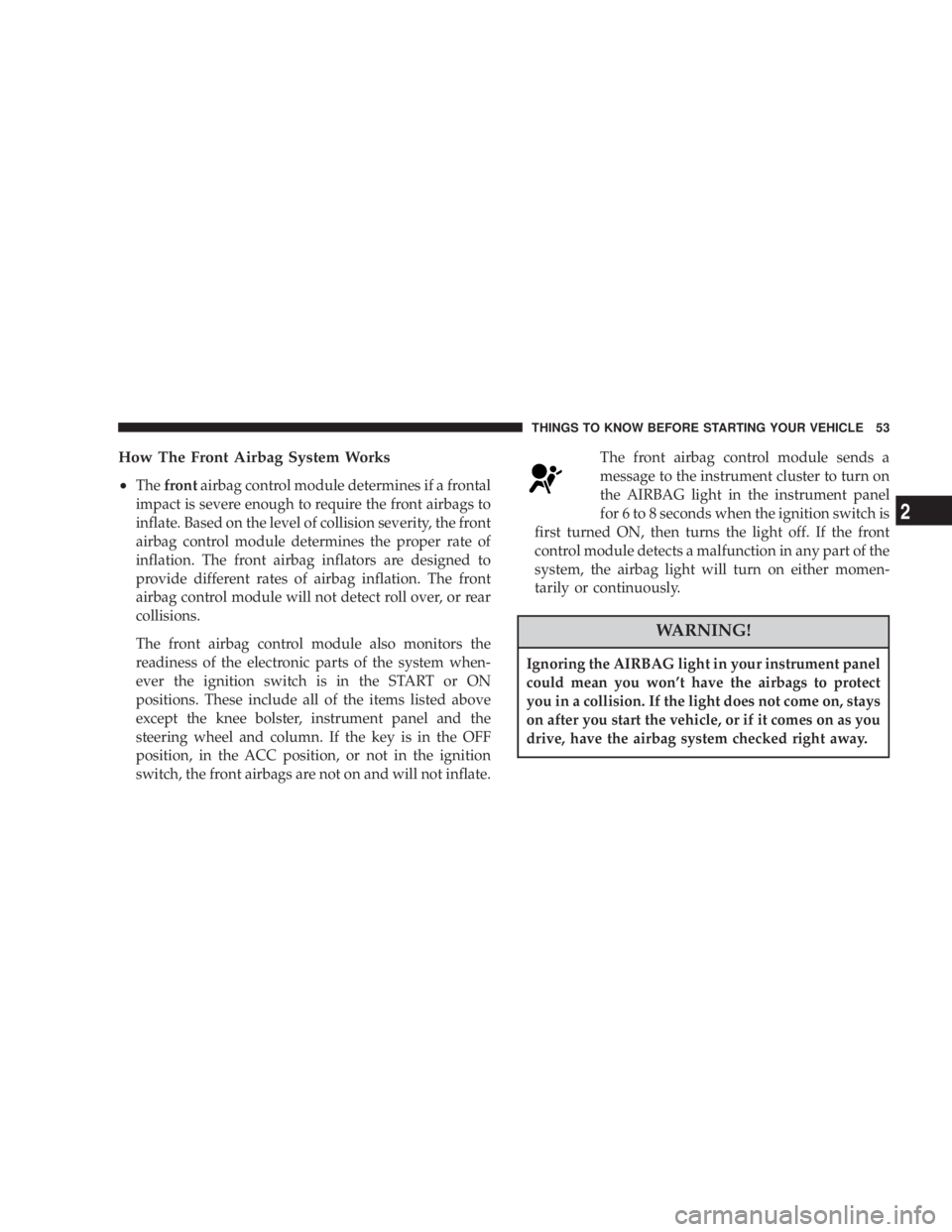
How The Front Airbag System Works
² The front airbag control module determines if a frontal
impact is severe enough to require the front airbags to
inflate. Based on the level of collision severity, the front
airbag control module determines the proper rate of
inflation. The front airbag inflators are designed to
provide different rates of airbag inflation. The front
airbag control module will not detect roll over, or rear
collisions.
The front airbag control module also monitors the
readiness of the electronic parts of the system when-
ever the ignition switch is in the START or ON
positions. These include all of the items listed above
except the knee bolster, instrument panel and the
steering wheel and column. If the key is in the OFF
position, in the ACC position, or not in the ignition
switch, the front airbags are not on and will not inflate. The front airbag control module sends a
message to the instrument cluster to turn on
the AIRBAG light in the instrument panel
for 6 to 8 seconds when the ignition switch is
first turned ON, then turns the light off. If the front
control module detects a malfunction in any part of the
system, the airbag light will turn on either momen-
tarily or continuously.
WARNING!Ignoring the AIRBAG light in your instrument panel
could mean you won't have the airbags to protect
you in a collision. If the light does not come on, stays
on after you start the vehicle, or if it comes on as you
drive, have the airbag system checked right away. THINGS TO KNOW BEFORE STARTING YOUR VEHICLE 53
2